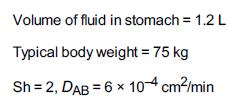An antibiotic drug is contained in a solid inner core and is surrounded by an outer coating
Question:
An antibiotic drug is contained in a solid inner core and is surrounded by an outer coating that makes it palatable. The outer coating and the drug are dissolved at different rates in the stomach, owing to their differences in equilibrium solubilities.
a. If D2 = 4 mm and D1 = 3 mm, calculate the time necessary for the pill to dissolve completely.
b. Assuming first-order kinetics (kA = 10 h–1) for the absorption of the dissolved drug (i.e., in solution in the stomach) into the bloodstream, plot the concentration in grams of the drug in the blood per gram of body weight as a function of time when the following three pills are taken simultaneously:
Pill 1:D2=5 mm,D1=3 mmPill 2:D2=4 mm,D1=3 mmPill 3:D2=3.5 mm,D1=3 mm
c. Discuss how you would maintain the drug level in the blood at a constant level using different-size pills?
d. How could you arrange a distribution of pill sizes so that the concentration in the blood was constant over a period (e.g., 3 hr) of time?
Additional information:
Amount of drug in inner core = 500 mg
Solubility of outer layer at stomach conditions = 1.0 mg/cm3
Solubility of inner layer at stomach conditions = 0.4 mg/cm3
Step by Step Answer:






